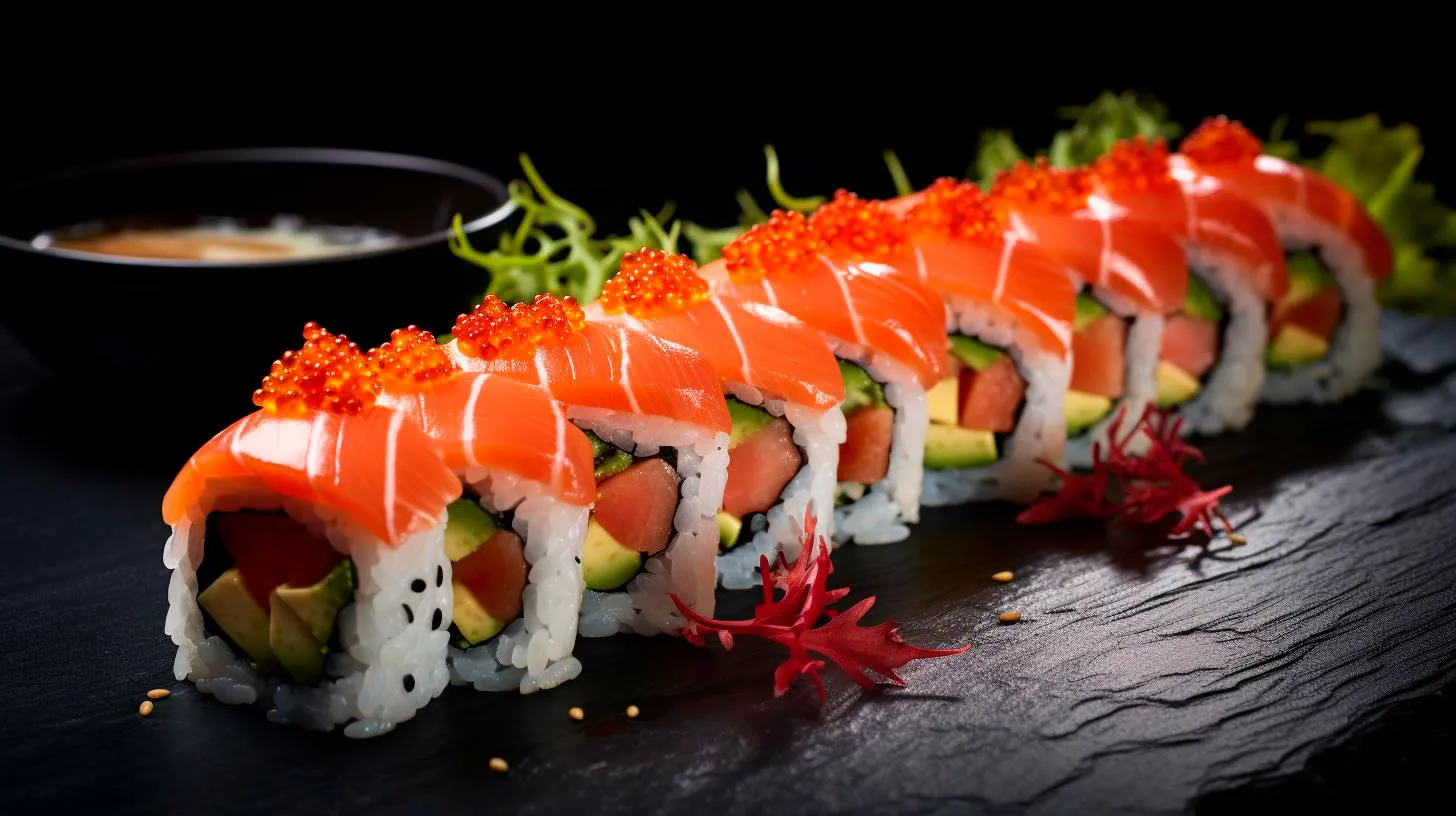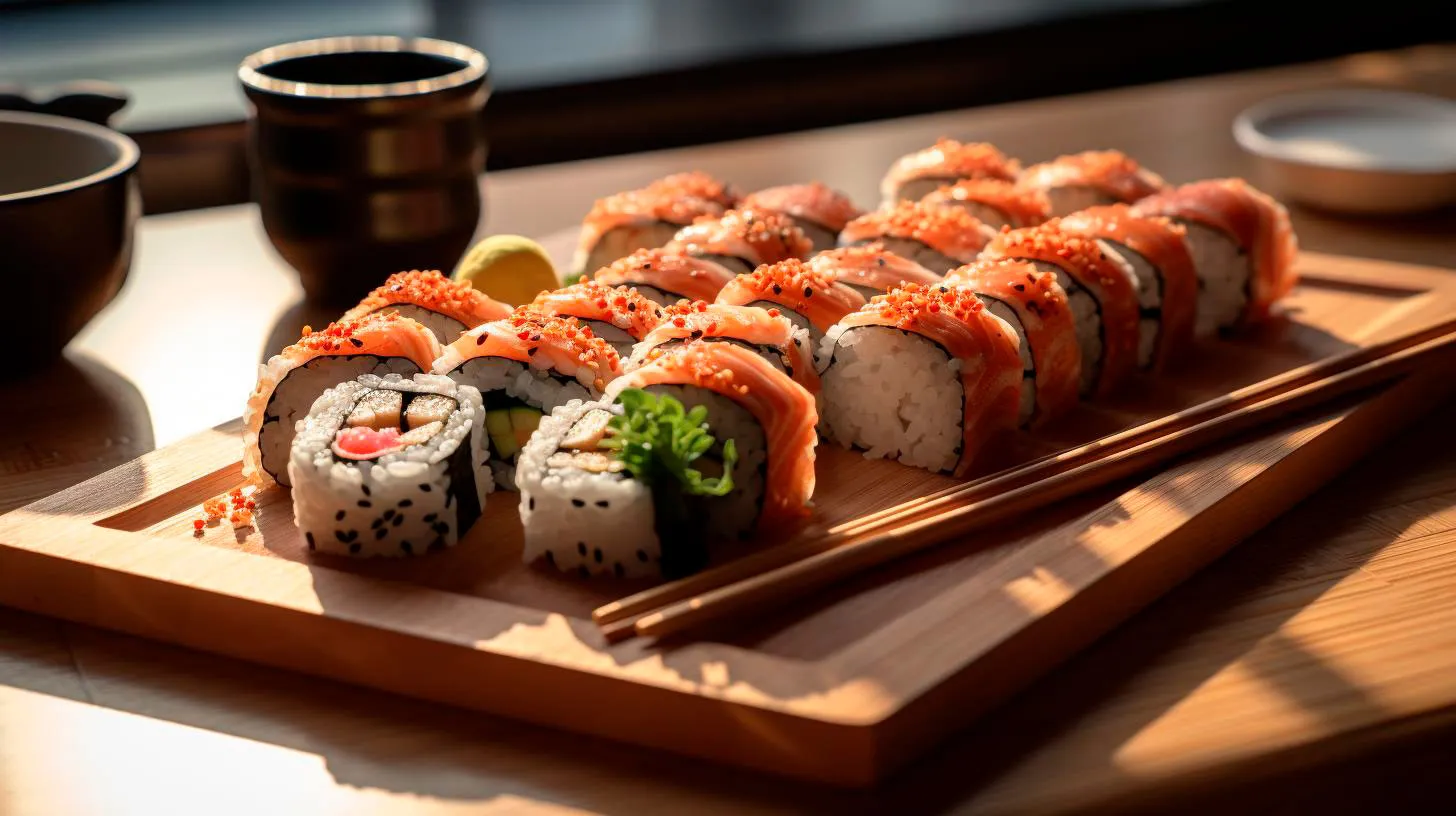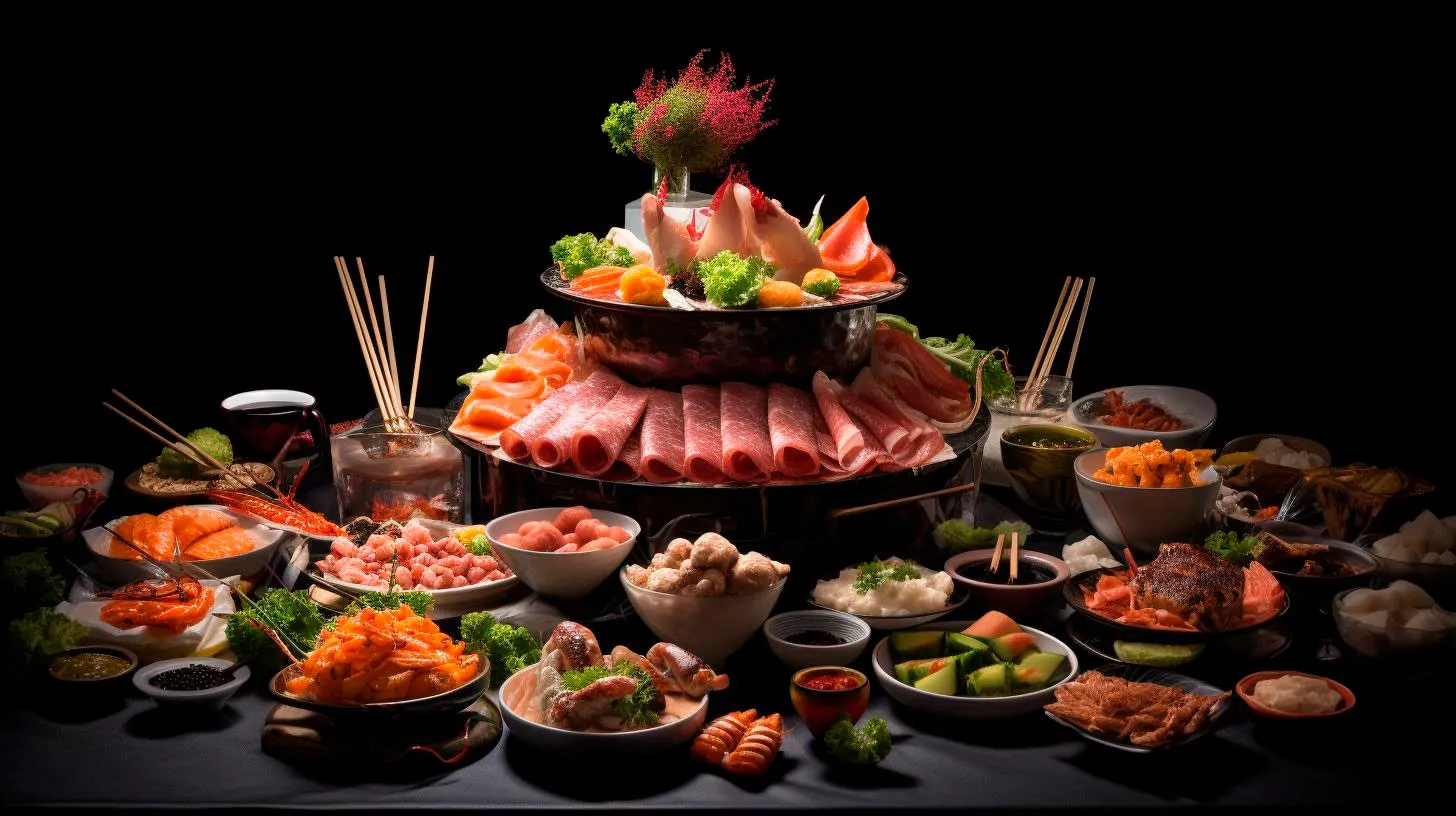Exploring the Delicate Fusion of Flavors in Nigiri Sushi
The Essence of Nigiri Sushi
Nigiri sushi is a type of sushi that consists of a small hand-formed mound of rice topped with a thinly sliced piece of seafood or other ingredients. The simplicity of its composition allows the natural flavors of the ingredients to shine through. This style of sushi is often considered the epitome of sushi craftsmanship, where skilled hands transform a few basic ingredients into a delectable and visually appealing creation.
The Perfect Combination of Ingredients
One of the key aspects that sets Nigiri sushi apart is the careful pairing of ingredients. While fish is the most common topping, other seafood like shrimp, squid, and eel, as well as omelet, tofu, and even vegetables, can also be used. The choice of fish differs based on its fat content, texture, and flavor profile. For instance:
- Fatty fish like tuna and salmon provide a rich, buttery flavor.
- White fish like sea bass and snapper offer a delicate and subtle taste.
- Shellfish, such as sweet shrimp and scallops, provide a sweet and briny flavor.
The combination of the right fish with the seasoned sushi rice creates a harmonious balance of flavors that dance on your taste buds with each bite.
The Art of Crafting Nigiri Sushi
Nigiri sushi is not only about taste; it is also an art form. The skilled sushi chef goes through years of training to perfect the craft of making Nigiri sushi. Here is a glimpse into the meticulous process:
- Preparing the Rice: The sushi rice is the foundation of Nigiri sushi. It is seasoned with a delicate blend of rice vinegar, sugar, and salt to provide the perfect balance to the toppings.
- Choosing the Fish: The sushi chef carefully selects the freshest fish from reputable suppliers, ensuring its quality and taste.
- Slicing with Precision: The chef uses a sharp knife to cut the fish into thin, uniform slices, considering the texture and thickness required for each type of fish.
- Forming the Nigiri: With skilled hands, the chef forms a small mound of rice and gently presses the fish on top, creating a beautiful piece of Nigiri sushi.
The artistry and precision involved in crafting each piece of Nigiri sushi elevate the dining experience to a whole new level.
The Joy of Eating Nigiri Sushi
When you indulge in Nigiri sushi, you embark on a sensory journey. The combination of the perfectly seasoned rice and the fresh, high-quality fish creates an explosion of flavors in your mouth. Some key takeaways of this delightful experience include:
- The simplicity of Nigiri sushi allows you to appreciate the purity of taste and texture of each ingredient.
- The balance of flavors between the rice and fish is crucial, creating a symphony of tastes that blend harmoniously.
- Nigiri sushi enables you to explore a wide variety of seafood options and expand your culinary horizons.
- It is a testament to the skill and expertise of sushi chefs who dedicate their lives to mastering this art form.
The popularity of Nigiri sushi has soared in recent years, with people worldwide embracing the unique flavors and cultural experience it offers. According to a survey conducted by the Japan External Trade Organization, over 80% of respondents in the United States ranked sushi as their top choice among Japanese cuisine, highlighting the widespread love for this delicacy.
In conclusion, Nigiri sushi showcases the delicacy of Japanese cuisine in its purest form. From the careful selection of ingredients to the intricate artistry involved in its preparation, every aspect contributes to creating an unparalleled culinary experience. So, the next time you have the opportunity, seek out a renowned sushi bar and treat yourself to the delightful fusion of flavors that Nigiri sushi offers.
Nigiri Sushi: The Art of Bite-sized Perfection
In this article, we will delve into the world of nigiri sushi, its history, preparation techniques, and why it continues to be a beloved dish worldwide.
The Origins of Nigiri Sushi
Nigiri sushi traces its roots back to the early 19th century in Tokyo, Japan. Originally known as Edomae sushi, it was created by sushi chefs who sought to enhance the taste of raw fish by placing it on top of a small, oblong-shaped mound of hand-pressed rice. This innovation allowed the fish to meld with the rice, resulting in a harmonious blend of flavors.
The word “nigiri” translates to “hand-pressed,” which perfectly describes the technique used to create this sushi. The simplicity of its preparation allows the focus to be on showcasing the quality of the ingredients rather than complicating the dish with excessive flavors and textures.
Artistry in Nigiri Sushi Preparation
Creating nigiri sushi is an art form in itself. Skilled sushi chefs spend years perfecting their techniques to ensure that each piece is a masterpiece. The attention to detail is evident in every step of the process, from selecting the freshest fish to molding the rice with precision.
Here are some key steps involved in the preparation of nigiri sushi:
- Choosing the fish: High-quality and fresh fish is crucial for nigiri sushi. Chefs carefully select the best cuts to ensure optimal flavor and texture.
- Rice perfection: Sushi rice is cooked with a specific ratio of vinegar, sugar, and salt to achieve the perfect balance of flavors. The rice is then cooled and shaped into small, bite-sized pieces by the skilled hands of the chef.
- Wasabi wizardry: A small amount of wasabi is placed between the fish and rice to add a kick of heat and complement the flavors. The amount used is carefully regulated to avoid overpowering the delicate taste of the fish.
- Cutting with precision: The chef uses a sharp knife to slice the fish precisely and uniformly, ensuring each piece has an aesthetically pleasing appearance.
The Advantages of Nigiri Sushi
Nigiri sushi offers a range of advantages that contribute to its popularity:
- Freshness: The simplicity of nigiri sushi allows the quality and freshness of the fish to shine through, providing a truly authentic taste experience.
- Variety: Nigiri sushi can be prepared with various types of fish, which allows for a diverse selection and a chance to explore different flavors.
- Portion control: The bite-sized nature of nigiri sushi enables diners to try a variety of options without feeling overwhelmed or excessively full.
- Visual appeal: The presentation of nigiri sushi is incredibly pleasing to the eye, beautifully showcasing the colors and textures of the fish.
Key Takeaways
Nigiri sushi is a culinary art that continues to captivate sushi enthusiasts around the world. Here are some key takeaways about this bite-sized perfection:
- Nigiri sushi originated in Tokyo in the early 19th century and has since become a beloved dish globally.
- Skilled chefs devote years to perfecting the art of nigiri sushi preparation, ensuring each piece is a work of culinary art.
- The simplicity and focus on quality ingredients are the foundations of nigiri sushi, allowing the flavors to shine through.
- Nigiri sushi offers freshness, variety, portion control, and visual appeal, making it a delightful choice for sushi lovers.
In conclusion
Next time you have the opportunity to indulge in nigiri sushi, take a moment to appreciate the harmony between the fish, rice, and subtle wasabi heat. This unique culinary experience showcases the artistry and precision behind each bite-sized masterpiece and continues to be a beloved choice for sushi aficionados worldwide.
Nigiri Sushi: A Melting Pot of Sensational Flavors
This delicate combination of vinegared rice and toppings showcases a harmonious blend of textures and flavors that is simply irresistible.
Let’s dive into the world of nigiri sushi and uncover the secrets behind its popularity and the artistry involved in creating these bite-sized flavor bombs.
The Art of Nigiri Sushi
At first glance, nigiri sushi may seem simple with just a small mound of rice topped with seafood or other ingredients. However, it is the meticulous attention to detail and skill that goes into crafting each piece that sets nigiri sushi apart.
The process begins with seasoned sushi rice, also known as shari. The rice should be slightly warm, giving it a distinct texture that holds together when shaped. Each grain is carefully seasoned with a blend of vinegar, sugar, and salt, resulting in a perfectly balanced flavor profile.
The next step is to top the rice with ingredients like fresh fish, shrimp, or other seafood. The selection of toppings is vast, with options ranging from traditional choices like salmon, tuna, or mackerel to more exotic selections like sea urchin or eel. The chef’s expertise comes into play here as they consider the flavors, textures, and colors that will complement each other in every bite.
The final touch is the delicate formation of the sushi itself. The chef expertly shapes the rice and topping into a compact, bite-sized piece that is both visually appealing and easy to eat. The result is a work of art that showcases the harmony of flavors and textures.
The Flavorful Advantages of Nigiri Sushi
Nigiri sushi offers a multitude of flavors and advantages that keep sushi enthusiasts coming back for more. Here are some key takeaways:
- Authentic Flavors: Nigiri sushi highlights the natural flavors of the fish or other toppings. The balance between the vinegared rice and the topping allows the taste of the ingredient to shine through.
- Textural Bliss: The combination of the soft, slightly sticky rice with the fresh and often slightly firm topping creates a sensational contrast in textures that adds another layer of enjoyment.
- Versatile Options: Nigiri sushi offers a world of possibilities with an array of toppings to suit every palate. From raw fish to cooked seafood or even vegetarian options, there is something for everyone.
- Health Benefits: Fish, a common topping in nigiri sushi, is a great source of lean protein and omega-3 fatty acids, which contribute to a healthy diet and overall well-being.
Industry Statistics on Nigiri Sushi
Nigiri sushi has gained immense popularity worldwide, and the numbers speak for themselves:
- In the United States alone, the sushi market was valued at $2.75 billion in 2020. It is expected to reach $3.71 billion by 2026, with nigiri sushi being a significant contributor to this growth.
- According to a survey, 87% of sushi consumers in the UK prefer nigiri sushi over other sushi varieties like maki or temaki.
- Japan, the birthplace of sushi, has witnessed a surge in tourists visiting the country to experience authentic nigiri sushi, contributing to its thriving culinary tourism industry.
In conclusion, nigiri sushi brings together the artistry of skilled sushi chefs and a symphony of flavors that make it a true culinary masterpiece. The delicate balance of vinegared rice and fresh toppings creates a sensory experience that transcends cultural boundaries. Whether you are a sushi aficionado or a curious food lover, nigiri sushi is a must-try dish that will transport your taste buds on a journey you won’t soon forget.
Unveiling the Secrets Behind the Harmonious Taste of Nigiri Sushi
In this article, we will delve into the secrets behind this harmonious taste and explore why nigiri sushi continues to captivate the taste buds of people worldwide.
The Importance of High-Quality Ingredients
When it comes to nigiri sushi, the quality of the ingredients cannot be compromised. Every component plays a crucial role in achieving that harmonious taste. Here are some key points to consider:
- Fresh Fish: The foundation of nigiri sushi lies in the freshness of the fish. Chefs carefully select the highest quality fish available in the market, ensuring its freshness and flavor.
- Sushi Rice: The rice used in nigiri sushi is not your average rice. It is specially prepared by seasoned sushi chefs who are skilled in the art of sushi rice-making. The type of rice and the vinegar mixture used are key factors in achieving the perfect balance of flavors.
The Art of Slicing
One of the secrets behind the harmonious taste of nigiri sushi lies in the art of slicing the fish. Sushi chefs undergo rigorous training to master the precise techniques required to slice the fish correctly. Here’s why the art of slicing is essential:
- Texture: The way the fish is sliced affects its texture. Sushi chefs take into consideration the type of fish and cut it in a way that enhances its natural texture, resulting in a delightful mouthfeel.
- Visual Appeal: The presentation of nigiri sushi is just as important as its taste. The skillful slicing of the fish creates visually appealing pieces that make the dining experience even more enjoyable.
The Role of Umami
Umami is known as the fifth taste, often described as a rich and savory flavor. It plays a significant role in the harmonious taste of nigiri sushi. Here’s how umami comes into play:
- Marination: Some fish used in nigiri sushi are marinated to enhance their umami flavor. Common marinades include soy sauce, mirin, and sake. This extra step adds depth and complexity to the overall taste profile of the sushi.
- Garnishes: Nigiri sushi is often served with various garnishes like wasabi, pickled ginger, and soy sauce. These condiments further elevate the umami experience and complement the flavors of the sushi.
Key Takeaways
Nigiri sushi is an intricate culinary masterpiece that requires skill, precision, and attention to detail. Here are the key takeaways to appreciate the harmonious taste of nigiri sushi:
- The quality of ingredients, especially the freshness of the fish and the preparation of sushi rice, is paramount.
- The art of slicing the fish is crucial for both texture and visual appeal.
- Umami, the fifth taste, enhances the overall flavor of nigiri sushi through marination and garnishes.
Next time you indulge in nigiri sushi, take a moment to savor the harmonious combination of flavors, textures, and visual beauty. Each bite is a testament to the centuries-old art of sushi-making and the dedication of the sushi chef.



